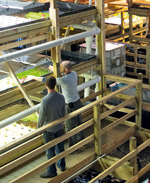- A bright future for fish farming
- > It is highly unlikely that wild capture fisheries will be able to produce higher yields in future. For aquaculture the opposite is the case. No other food production sector has grown as fast over the past 20 years. Abuses such as antibiotics in fish feed and the over-fertilization of marine waters, however, have brought the industry into disrepute. It must now prove that large-scale fish farming is possible without placing unacceptable demands on the environment.

The future of farmed fish
Driven mainly by massive population growth, urbanization and increasing wealth in Asia, aquaculture has grown by a good 8 per cent per annum over the past 20 years – faster than any other food sector. Today about 60 million tonnes of fish, mussels, crab and other aquatic organisms are farmed around the world each year. This is almost equal to the amount of ocean fish and seafood captured in the wild, which totalled 78.9 million tonnes in 2011. Asia, particularly China, is the most important aquaculture region, currently supplying 89 per cent of global production. Aquaculture will continue to grow strongly and thus make a significant contribution to providing the global population with valuable protein. An advantage of aquaculture is that much fewer feedstuffs are needed to farm fish and seafood than beef and pigs. It takes 15 times as much feed to produce 1 kilogram of beef as to produce 1 kilogram of carp. Aquaculture is thus a resource-efficient method per se of producing protein-rich food from animals. Current studies investigating likely developments to 2050 indicate that aquaculture is capable of satisfying the world population’s growing need for fish. This ongoing growth, however, must not come at the cost of the environment or the climate. It is problematic that aquaculture still requires large amounts of wild fish, which is processed into fishmeal and fish oil and used as feed. Although the volumes of these commodities have been stagnating for years, in some cases they still make use of fish stocks which are not managed in a sustainable manner. Aquaculture can thus still be a contributor to the problem of over-fishing. Efforts are now being made to reduce the amount of fishmeal and fish oil used in fish farming, not least because prices have soared as a result of high demand in China. Many research groups are developing alternative types of fatty, protein-rich feed from potatoes and rapeseed. In many cases aquaculture production is still not sustainable. Facilities require too much energy and generate nutrient-rich effluent which is often channelled into rivers and coastal waters in an untreated state. The waters then become over-fertilized, causing algal bloom and oxygen-deprived dead zones. Scientists are now developing methods to analyse the full life cycle of aquaculture facilities – life cycle assessments. For some time now the industry has been testing products for their environmental compatibility, embracing all aspects from the extraction of the raw materials through to recycling. The intensive rearing of carp and shrimps in ponds is considered very harmful. It scores extremely poorly in the life cycle assessment because it uses too much feed, produces nutrient-rich effluent, and consumes large amounts of energy. Yet in recent years environmental awareness has also become more widespread in the aquaculture sector. A change of thinking is evident, particularly in the industrialized nations which import large volumes of fish from Asia. Increasingly traders and customers are demanding goods which comply with environmental standards. For some years there have been sustainability certificates for marine capture fisheries, and products bearing this label are very much in demand. Soon the “Aquaculture Stewardship Council” certificate, a seal of approval for aquaculture operations, will be appearing on European markets. Traders and producers wishing to have this certificate must undertake to protect species, the environment and the water in farmed areas, and comply with a high level of social standards. We have an opportunity to gear the further expansion of aquaculture towards sustainability. Current environmental problems, over-fishing and climate change make this a matter of urgency.

